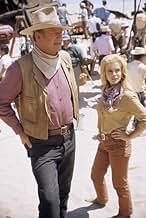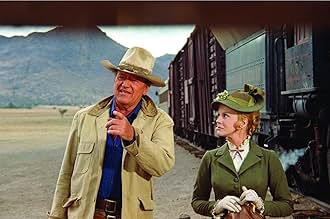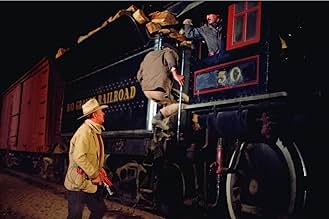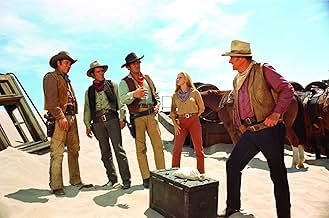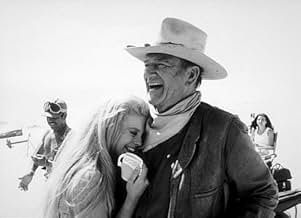CALIFICACIÓN DE IMDb
6.4/10
7.2 k
TU CALIFICACIÓN
Un pistolero llamado Lane es contratado por una viuda, la Sra. Lowe, para encontrar el oro robado por su esposo para que ella pueda devolverlo y comenzar de nuevo.Un pistolero llamado Lane es contratado por una viuda, la Sra. Lowe, para encontrar el oro robado por su esposo para que ella pueda devolverlo y comenzar de nuevo.Un pistolero llamado Lane es contratado por una viuda, la Sra. Lowe, para encontrar el oro robado por su esposo para que ella pueda devolverlo y comenzar de nuevo.
- Dirección
- Guionista
- Elenco
- Dirección
- Guionista
- Todo el elenco y el equipo
- Producción, taquilla y más en IMDbPro
Opiniones destacadas
The film western had already been beaten dead for US audiences by the endless stream of television westerns. The vicious surrealism of the spaghetti western had essentially overwhelmed the clichés of Hollywood. What's a film maker to do? Clint Eastwood successfully made post-westerns by following the cynical, mysterious world-weary character he originated in the Leone films. What did everyone else do? Here's an example.
The film starts with a modest imitation of the masterful opening sequence of Leone's "Once upon a Time in the West" while some characters wait for Wayne to arrive on a train. When Wayne finally appears the film switches back into Hollywood style. The dialog is largely by the book and the characters are about as interesting as any you would find in an average TV western. The photography is very good but it can't make up for the fact that at least 20 minutes of the film are long boring scenes of John Wayne and his pals riding around on horses against spectacular vistas. Sometimes they are being followed by a mysterious group of hooligans who pass the same vistas, same camera shot!
The first 20 minutes of the film has no music but when Mr. Frontiere's orchestra kicks in (during those boring horse riding sequences), we are treated to bombastic western cliché music. Frontiere did some really good soundtracks elsewhere but this pales against much of Ennio Morricone's spaghetti western soundtracks.
To the film's credit there are some good sequences and dialog. The scene with a crashed train that's half buried in the desert is neat. And the last scene in the film is funny, almost makes up for the rest of the film. This could have been good but it would have had to be done in the 1950's when the western wasn't so pickled.
The film starts with a modest imitation of the masterful opening sequence of Leone's "Once upon a Time in the West" while some characters wait for Wayne to arrive on a train. When Wayne finally appears the film switches back into Hollywood style. The dialog is largely by the book and the characters are about as interesting as any you would find in an average TV western. The photography is very good but it can't make up for the fact that at least 20 minutes of the film are long boring scenes of John Wayne and his pals riding around on horses against spectacular vistas. Sometimes they are being followed by a mysterious group of hooligans who pass the same vistas, same camera shot!
The first 20 minutes of the film has no music but when Mr. Frontiere's orchestra kicks in (during those boring horse riding sequences), we are treated to bombastic western cliché music. Frontiere did some really good soundtracks elsewhere but this pales against much of Ennio Morricone's spaghetti western soundtracks.
To the film's credit there are some good sequences and dialog. The scene with a crashed train that's half buried in the desert is neat. And the last scene in the film is funny, almost makes up for the rest of the film. This could have been good but it would have had to be done in the 1950's when the western wasn't so pickled.
I find The Train Robbers to be a surprisingly under-appreciated western. The more times I see it, the more I appreciate it myself. Sure, the feel and the look may be old-fashioned for its time but I don't care. Kennedy, Wayne and the rest of the group have obviously settled to make a fine basic western romp, not a new-styled masterpiece, and have reached the goal with very satisfying results. There can be seen a few little touches of Leone's 'Once Upon a Time in the West' (the first scene of Ben Johnson waiting at the train station), Siegel's 'Two Mules for Sister Sara' (a sister Sara-type treatment of the female character) or Hill's 'Butch Cassidy & the Sundance Kid' (the pursuing gang of riders). It also brings to mind Peckinpah's 'Ride the High Country'. But after these slight touches it's always back to the good old' Wayne stuff and I have nothing to complain about that.
With the music underlining heavily the handsome photography makes some highly iconic and beautiful pictures. There are frames that look a lot like classic western paintings. The nature and the people are seen beautifully during the long ride through deserts, rivers and storms. Sometimes it almost feels like watching 'Easy Rider' of the Wayne generation on horses. "Let's go to Mexico."
The action works fine like it always does when these old times film pros have been on the job. The men might be saddle-weary, but still gutsy enough and well worn like good saddle leather. You can tell the experience and good times as well from their voices. There is also a lot of warmth shining out of them, specially from Wayne's side. Ann-Margret has no real competition being the only woman in the picture. Besides "sticking out from the right places" she holds up pretty well especially with Wayne, who easily blew other actors aside with his strong presence on the screen.
With appropriately ironic note to its end the whole raid for the lost gold serves as a very good early seventies western and a decent one in Wayne's canon.
With the music underlining heavily the handsome photography makes some highly iconic and beautiful pictures. There are frames that look a lot like classic western paintings. The nature and the people are seen beautifully during the long ride through deserts, rivers and storms. Sometimes it almost feels like watching 'Easy Rider' of the Wayne generation on horses. "Let's go to Mexico."
The action works fine like it always does when these old times film pros have been on the job. The men might be saddle-weary, but still gutsy enough and well worn like good saddle leather. You can tell the experience and good times as well from their voices. There is also a lot of warmth shining out of them, specially from Wayne's side. Ann-Margret has no real competition being the only woman in the picture. Besides "sticking out from the right places" she holds up pretty well especially with Wayne, who easily blew other actors aside with his strong presence on the screen.
With appropriately ironic note to its end the whole raid for the lost gold serves as a very good early seventies western and a decent one in Wayne's canon.
Mrs. Lowe (Ann Margret) is the widow who enlists the help of Lane (John Wayne) in finding a gold shipment that had been stolen five years ago
In that time ten men rode away with half a million in gold The fellow that was running the show figured they better hide it until things cooled off So he took the Fargo box and rode south into Mexico He had the misfortune of getting shot But before he died, he told his wifethe mother of his little boy where the gold was
But his widow decided to get the gold, return it to the train company for a $50,000 reward, and clear her husband's name The reason: she doesn't want her kid growing up thinking his old man ran around robbing trains
In mid way, and as 'gold has a way of bringing out the larceny in all of us,' Wayne, with his old-times pals and two young helpers, find themselves followed by mysterious riders who also want the buried loot
"The Train Robbers" features plenty of gorgeous vistas, from rocky scrub to a sea of rippling sand dunes Also Wayne delivers one of his most memorable lines addressing Margret, 'I've got a saddle that's older than you are, Mrs. Lowe.'
In that time ten men rode away with half a million in gold The fellow that was running the show figured they better hide it until things cooled off So he took the Fargo box and rode south into Mexico He had the misfortune of getting shot But before he died, he told his wifethe mother of his little boy where the gold was
But his widow decided to get the gold, return it to the train company for a $50,000 reward, and clear her husband's name The reason: she doesn't want her kid growing up thinking his old man ran around robbing trains
In mid way, and as 'gold has a way of bringing out the larceny in all of us,' Wayne, with his old-times pals and two young helpers, find themselves followed by mysterious riders who also want the buried loot
"The Train Robbers" features plenty of gorgeous vistas, from rocky scrub to a sea of rippling sand dunes Also Wayne delivers one of his most memorable lines addressing Margret, 'I've got a saddle that's older than you are, Mrs. Lowe.'
Whilst the Western genre for movies has died out since the sixties, most, if not all, John Wayne films are good and enjoyable today. However, with that said, this film (to the seasoned Western viewer) feels like nothing new and exciting. And again, with that said, it is not a bad film by any means. John Wayne puts up, yet again, a stellar performance with the backdrop being a decent adventure film with enough action to entice you for its duration.
Whilst nothing brilliant, The Train Robbers is just an easy film to watch and make time fly. If you are not a Western fan, then give this one a miss because it will not promote you to watch another one, but for the more fans of the genre, this will not be so hit and miss for you.
Whilst nothing brilliant, The Train Robbers is just an easy film to watch and make time fly. If you are not a Western fan, then give this one a miss because it will not promote you to watch another one, but for the more fans of the genre, this will not be so hit and miss for you.
I was in college when I first saw THE TRAIN ROBBERS. I was already a die hard John Wayne fan. I followed his later career with great interest. Since due to the political climate of the day one was not the most popular individual on a campus declaring the fact that you liked this star's work. I didn't simply declare this fact. I shouted it from the rooftops. I dragged all my friends to see this picture because I felt it both reflected the best of Duke's earlier work and still stayed consistent with the aging hero he was portraying. Burt Kennedy's lean and taut script reminded me of the best of his work on the Randolph Scott and Budd Boetticher westerns of the fifties. The simple yarn of Ann-Margret hiring John Wayne and his crew of Ben Johnson, Rod Taylor,Christopher George, Jerry Gatlin and Bobby Vinton to recover half a million dollars in stolen gold is very simple in it's directness. They are are gunmen who just stay on the right side of the law. If they were japanese they could almost be described as landless sellswords or ronin. They exist simply from job to job. The status quo for Lane John Wayne's character is changed by the presence of the woman. Mrs. Lowe, He finds himself sexually attracted to Mrs. Lane, a woman young enough to be his daughter yet still capable of reminding him of the things he's lost in his life.Ann-Margret's character is curious about Lane who won't or more importantly can't talk about himself. Ben Johnson's character Jesse fills in the the necessary exposition but never tells more than he immediately has to. Burt Kennedy also plays with his audience. In BUTCH CASSIDY AND THE SUNDANCE KID George Roy Hill has his leads chased by faceless men that they eventually are able to identify. In THE TRAIN ROBBERS our crew is chased by nameless men we never get to identify, people who remain throughout the film as a constant unknown quantity. This is a situation I don't recall ever seeing before in an A grade Wayne western. There is a scene toward the end of the film where Mrs. Lowe makes an overture to Lane which he reluctantly rejects. He feels he is too old to have feelings of this nature. The film starts to proceed to what might be considered a predictable conclusion. Burt Kennedy does not oblige. He gives us a surprise ending that totally satisfies on each and every viewing. There are other considerable assets to this project. Dominic Frontiere's score is a rouser. The opening of the film and the first fifteen minutes contain no score at all. All of a sudden we have an expansive score on the par with Alfred Newman's HOW THE WEST WAS WON or Jerome Moross's THE BIG COUNTRY. The only other score Mr. Frontiere ever delivered on a par with this film was Ted Post's HANG'EM HIGH. The other major contributor to this project was William H Clothier superb cinematography. This was the last of his 17 collaborations with the Duke and no movie ever looked cleaner or sharper. I know this film has many detractors. Everyone is entitled to his opinion but I feel this is on the high end of Duke's later work. As for Burt Kennedy I feel he delivered a movie even Howard Hawks would have liked to claim as his own.
¿Sabías que…?
- TriviaDirector Burt Kennedy wanted to cast Jack Elam as Grady. However John Wayne would not allow this, because he felt Elam had stolen too many scenes from him in Río Lobo (1970).
- ErroresDuring the era depicted, the price of gold in US dollars was fixed at $20.67 per troy ounce. $500,000 worth of gold would therefore weigh about 750 kg or 1,660 pounds avoirdupois - far too much for one man to shift or for one mule to carry, as depicted in different scenes.
- ConexionesEdited into Ann-Margret: Från Valsjöbyn till Hollywood (2014)
Selecciones populares
Inicia sesión para calificar y agrega a la lista de videos para obtener recomendaciones personalizadas
- How long is The Train Robbers?Con tecnología de Alexa
Detalles
- Tiempo de ejecución1 hora 32 minutos
- Mezcla de sonido
- Relación de aspecto
- 2.39 : 1
Contribuir a esta página
Sugiere una edición o agrega el contenido que falta

Principales brechas de datos
By what name was Los chacales del oeste (1973) officially released in India in Hindi?
Responda

